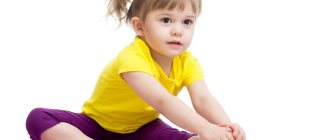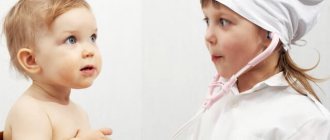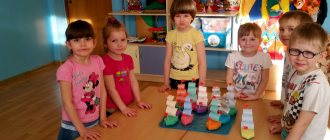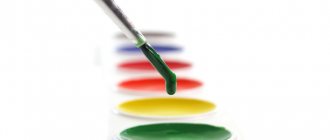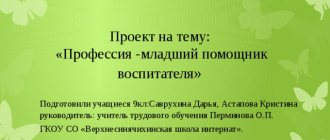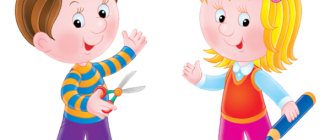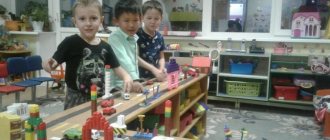Project activities
Project activity is a method of inclusion, since it is aimed at all interested children, takes into account all their characteristics and is designed to provide integrative education based on participation, cooperation and an individual approach in the distribution of responsibilities. Project activity in kindergarten is a complex joint work of teachers, children and their parents, during which children develop cognitive abilities and creative thinking, increase their self-esteem, learn to search for information and use this knowledge in independent activities.
In the section of the site, project activities in kindergarten contain many interesting projects for children of different groups for the teacher to teach children on various topics:
- A project in kindergarten with parents on experimental activities on the topic “Scientific fun”
- Social and pedagogical project of the teacher “Kindergarten is a territory of kindness!”
- Project at the preschool educational institution “Let’s bow to those great years”
- Project "Magic Button" senior group
- Project on the topic "Transport" senior group
- Short-term project in kindergarten “Me and my friends”
- Summary of educational activities for teaching literacy in a preparatory school group on the topic “Journey to the Queen of Letters”
- Kindergarten teacher project “No one is forgotten, nothing is forgotten...”
- Creative project at the preschool educational institution “Our Grandmothers”
- Social and pedagogical project at the preschool educational institution “Hello, school!”
- Social project at the preschool educational institution "Interactive Museum"
- Teacher’s project “Working is always useful!”
- Creative project at the pre-school educational institution “Victory Day”
- Long-term creative project at the preschool educational institution “Children and the Road” for children from 4 to 5 years old
- Mini project in the middle group “The radiant sun warms us”
- Project work at the preschool educational institution “Let’s make a book with our own hands”
- Project at the preschool educational institution “Broad Maslenitsa” middle group
- Ecological project “Flower garden and vegetable garden on the window” II junior group of kindergarten
- Organization of project activities in preschool educational institutions according to Federal State Educational Standards for preschool education
- Project for educators and parents on the topic “Creation of a consultation center Children are our future”
The main goal of the project method in kindergarten is: the development of a free creative personality. The main tasks to achieve the goal are development tasks.
Project activity is the type of pedagogical work that will be in demand in connection with the implementation of federal state standards (FSES) into the practice of preschool educational institutions. Advantages of the project method: It is one of the forms of organizing educational work. There are also basic requirements for using the project method in kindergarten: at the heart of any project is a problem, the solution of which requires research; The required components of the project can be found in the section materials.
Technology of project activities in kindergarten. Today the state has set a task to prepare a completely new generation: active, inquisitive. Therefore, in the educational process of a preschool educational institution, project activities are in the nature of cooperation, in which children and teachers of the preschool educational institution take part, and parents and other family members are also involved. Projects, regardless of type, require constant attention, help and support from adults at every stage of implementation.
The project method presupposes the independent activity of kindergarten students, but the child cannot independently formulate a problem and determine the plan; he cannot be the author and organizer of project activities, needing the help of adults who are able to understand his interests and implement them in the upcoming activity. The beginning of any project in a preschool educational institution is associated with one of its important components - the interest of children.
The teacher’s task in project activities is to activate the child’s creative activity and promote independence in choosing a method of action in various situations. The goal of project activities in a preschool educational institution (DOU) should be an active and inquisitive, diversified and creatively free child.
Specifics of the project work of the kindergarten teaching staff
Project activity is an innovative method of working with children that has shown its high effectiveness in modern conditions. Pupils have the opportunity to search for new knowledge, their classification and concentration, creative free development, formation of the necessary life experience, taking into account the age group of students. Preschoolers learn the material they receive much better, so they develop stable knowledge and skills. At the same time, the teacher becomes closest to his students, and this is extremely important for the formation of strong trusting relationships.
The history of collaboration between children and teachers is not new, although in modern pedagogy it is considered an innovative theory. It began to be used at the beginning of the twentieth century with the spread of Dewey's pragmatic pedagogy. But it has become the most important and in demand today.
The use of project activities in preschool educational institutions according to the Federal State Educational Standard allows children to receive the following opportunities:
- Active development of independence, free critical thinking, initiative when participating in various projects.
- Implementation of the acquired theoretical knowledge into your everyday life.
- Setting boundaries between knowledge and ignorance.
- Experience working collaboratively with peers and adults.
Project activities also bring significant benefits to the teacher himself, since it provides the opportunity to successfully unlock the potential of students, qualitatively prepare children for independent study at school, and improve their own professional skills and capabilities.
In order to help staff cope with this important task, consultations are held for preschool teachers on project activities. They allow you not only to understand the principles of such work, but also to obtain valuable methodological information on its practical application. The effectiveness of the methods used is evidenced by the project activities of the senior educator.
The existing successful experience of a preschool teacher in project activities should be disseminated and applied by specialists from both the preschool institution itself and other kindergartens.
For the successful implementation of project activities in preschool educational institutions, work is carried out in middle and senior groups. This is due to the specifics of the psyche of children. Sustained attention, sufficiently mature to carry out the simplest analysis, cognitive abilities and a certain observation ability are formed in children by approximately 4–5 years. Therefore, the topics of project activities for educators must take into account the age characteristics of the students.
The main features of project activities in preschool educational institutions are the following:
- The problem that is proposed to be solved must be based on a situation that is important to children. It must be related to a situation that has already occurred or may cause difficulties in the future. At the same time, you need to understand that children are more willing to solve problems put forward by themselves than those offered to them by adults.
- For a project, you need to choose topics that do not have a solution that is too simple or obvious. If the answer is “before the eyes” of the students, the project will not produce any useful results.
- The result of the project activity should be a product that can be represented in the form of words, diagrams or symbols. A fixed time should be allotted for solving a problem, which allows students to develop the skills of following a plan and quickly responding to tasks.
In the implementation of new methods, self-education of the teacher in project activities is of great importance. He must clearly and firmly understand the difference between this type of work and methodology. A strict sequence of actions is contrasted with free interpretation within a certain educational focus. The effectiveness of the method used is confirmed by the teacher’s report on project activities in the middle or senior group.
How to properly formalize a project in a preschool educational institution
Documentation of the project.
Author: Shatokhina Rita Vyacheslavovna, teacher of additional education, MBU DO “House of Children's Creativity in Kalininsk, Saratov Region” In modern pedagogy, the project method is considered as one of the personally oriented teaching technologies. The project method is a pedagogical technology focused not on the integration of factual knowledge, but on its application and acquisition of new ones, sometimes through self-education.
Approximate design of the project.
Introduction. There is a problem. Work on a project is always aimed at solving a specific problem. No problem - no activity. What is the innovation of this project? Brief content of the project, a list of questions that the project participants pose to themselves. 1.1.Section. "The main part of the project." Setting goals and objectives, relevance. Determining the time to work on a project (short-term, long-term), determining the type of project: Projects are: a) research; b) creative; c) gaming; d) information projects; d) practice-oriented. 1.2. Action planning. During the analysis and discussion of the project, a plan of joint action between the student and the teacher is developed. A bank of ideas and proposals is being created. Throughout the entire work, the teacher helps in setting goals, corrects the work, but in no case imposes his vision of solving the problem. Project participants are divided into groups of 2 to 5 people, depending on the number of students in the group. Roles are assigned in each group: for example, idea generator, presenter, designer, critic, encyclopedist, secretary, etc. The tasks assigned to each group and the deadlines for their completion are clearly stated. The stages of work on the project can be reflected in an example table: Tasks or task. Deadlines. Solutions. Responsible for implementation. Or a group. Control. 1.3. Drawing up an estimate: what pedagogical, student, and material resources will be used to implement this project. It could just be a list. 1.4. Definition of the customer of this project: for whom? 1.5. Search for information. Provide sources. 1.6. Planned result. What will students gain? What will the teacher gain? 2. Section. 2.1. The result of the work is a product. Description of the work result: script, report, presentation, etc. Students, having chosen feasible technologies to create their work, clarify, analyze the collected information, and formulate conclusions. The teacher acts as a scientific consultant. The results of completed projects must be, as they say, “tangible”. If this is a theoretical problem, then a specific solution, if practical, a specific result, ready for use (in class, at school, in real life). 2.2. Presentation of results - presentation of the finished product. In other words, the implementation of the project requires, at the final stage, the presentation of the product and the defense of the project itself, which can be carried out in the form of a competition, exhibition, presentation, or speech. During the defense, students demonstrate and comment on the depth of development of the problem posed, its relevance, explain the result obtained, while developing their oratorical abilities. Each project is assessed by all class participants. Students watch the work of others with interest and, with the help of the teacher, learn to evaluate them. The result of the presentation can be reviews or comments from listeners, a link on the Internet, guests or parents, articles in the media, diplomas, certificates. 3. The final part of the project. Conduct reflection. Diagnostics. Suggested questions: Have you acquired new knowledge or skills while working on the project? What was the most interesting thing about working on the project? What were the main challenges and how did you overcome them? What comments and suggestions can you make for the future? Students can be encouraged by expressing gratitude in words or by presenting a diploma for a project developer, scientific researcher, best designer, etc.
We recommend watching:
Project in the senior group of a kindergarten Project in the senior group on the topic “Trees and shrubs in spring” Practice-oriented project for landscaping the territory of a kindergarten Educational project. Second junior group
Similar articles:
Educational and creative project on the theme “Golden Autumn”. Junior group
Project for children of the senior group “Our cheerful garden”
Types of projects
By type of activity, all projects can be divided into the following:
- Creative and research, the fruits of which are stands, showcases, wall newspapers, posters and so on. The teacher’s design and research activities in this case are aimed at developing children’s ability to experiment.
- Information projects are aimed at collecting and analyzing information, transforming it into material objects such as stands or various crafts.
- The use of projects using role-playing game themes allows you to solve the problem using different characters.
The most experienced teachers in this area can give a master class on project activities for educators, which will clearly demonstrate the effectiveness and significance of the method used.
Mini project
But how is “a river born”? Do you want to know? (places a wide and long blue strip of fabric on the floor).
There are many different rivers on earth, large and small, they all run somewhere. A big river is formed from many small rivers and streams. Do you want to make your own big river? The widest and longest strip of fabric will turn into the main river, the rest (you can use ribbons) into streams. Arrange the blue ribbons so that the streams flow into a large river. That's how much water there is, but you need to save it, don't even leave the taps open
While we were playing, you probably got thirsty, come to the table, look at the water, take a sip. What kind of water? (water has no taste)
Shows a glass of milk. Place spoons in a glass of milk and water. In which glass is the spoon visible and in which is it not? Why? Conclude that the water is clear, but the milk is not.
The teacher says that water can be warm, cold, hot. Offers to dip your finger in warm and cold water. In rivers, lakes and seas there is also warm and cold water. Some fish, animals, and plants can live only in warm water, others - in cold water. If you were a fish, what kind of water would you choose? Can anyone live in a hot “house”? (Very few residents)
You know so much about me, about water. I'm very pleased with this. I want to give each of you these boats.
Conversation for children of the younger group in kindergarten. Houseplants
Children:
for beauty, comfort, they purify the air.
Educator:
- Do you think indoor plants are alive?
- Why? Prove it. Children:
grow, breathe, drink.
Educator:
- How are indoor plants similar? Children: everyone has a root, stem, leaves, flowers. Educator: - What do all plants need to grow? Children: light, warmth, water, air.
Physical exercise “Flowers”.
The flower says to the flower: “Pick up your leaf.
Go out onto the path and tap your foot. Shake your head - Greet the sun in the morning! Tilt the stem slightly - Here is a charger for the flower. Now wash yourself, dust yourself off and calm down. Finally ready to greet the day in all its glory! What beautiful flowers! (Children perform movements according to the text) Educator:
- Guys, do you think all indoor plants should be cared for equally?
Children: no! Children take care of the plant. The teacher monitors the care and helps if necessary. After leaving, the equipment is put back in place. Educator: - Sveta, how will you care for the violet? Child: the violet cannot be sprayed, the leaves do not like water and may wither. Dust is carefully removed with a brush. Educator:
- Dasha, how will you care for aloe?
Child: the leaves should be washed with a wet brush so as not to break off the thorns. Educator:
- Ilyusha, remember how to loosen the soil?
Child: neatly, shallowly near the stem, but from the edge of the pot you can go deeper. Educator: - Why do you need to loosen the ground? Child: so that water flows well, the roots breathe and grow well. Educator: - Styopa, how to water the plants correctly? Child: place the spout of the watering can on the edge of the pot, pour little by little over the entire soil. Wait until the water is absorbed. Teacher:
- Guys, you did a good job.
Admire our indoor plants. What have they become? Children:
clean, well-groomed, beautiful, shiny
Teacher:
- What did you do to make the flowers look like this?
Children:
loosened the soil, watered it.
They wiped the leaves and sprayed them. Educator:
Now we know how to properly care for plants.
Short-term project in the senior group “Magic and Colors”
Children finish drawing bubbles. As the drawing progresses, guiding questions are asked, if necessary.
- Reflection.
Game “Good - Bad” (TRIZ)
Additional education teacher:
Guys, tell me, what's good about bubbles?
Children:
They are beautiful, you can play with them, they make us happy.
Additional education teacher:
What's wrong with bubbles?
Children:
They burst and can get into your eyes and sting.
Additional education teacher:
Well done, you know everything!
Additional education teacher:
So you and I have achieved real magic, a real miracle.
-Let's see who did what they did (works are being examined, the additional education teacher praises the children for their invention and resourcefulness).
-Guys, did you like drawing with bubbles?
-What was the most difficult thing for you?
-What's easy?
Children share their impressions.
Guys, you also drew bubbles today and I suggest finishing them in the group and organizing an exhibition of works called “The Tale of Soap Bubbles”
Consultation for parents
«
Drawing in unconventional ways"
The development of the creative potential of an individual should be carried out from early childhood, when a child, under the guidance of adults, begins to master various types of activities, including artistic ones. Great opportunities for the development of creativity lie in visual arts and, above all, drawing. Drawing is an important means of aesthetic education: it allows children to express their ideas about the world around them, develops fantasy and imagination, and makes it possible to consolidate knowledge about color and shape. In the process of drawing, the child improves his powers of observation, aesthetic perception, aesthetic emotions, artistic taste, creative abilities, and the ability to independently create something beautiful using accessible means. Drawing classes develop the ability to see beauty in the surrounding life, in works of art. Own artistic activity helps children gradually approach an understanding of works of painting, graphics, sculpture, and decorative and applied art. The image in the drawings is created using a variety of materials. Artists use various materials in their work: various chalks, paints, charcoal, sanguine, pastels and much more. And in children's creativity it is also necessary to include different paints (gouache, watercolor), ink, crayons, and teach children to use these visual materials in relation to their means of expression. Experience shows that drawing with unusual materials and original techniques allows children to experience unforgettable positive emotions. Emotions, as we know, are both a process and a result of practical activity, primarily artistic creativity. By emotions one can judge what pleases, interests, depresses, worries the child at the moment, what characterizes his essence, character, and individuality. Preschoolers, by nature, are able to sympathize with a literary hero, to play out various emotional states in a complex role-playing game, but to understand what beauty is and learn to express oneself in visual activity is a gift that one can only dream of, but it can also be taught. We adults need to develop a sense of beauty in a child. It depends on us how rich or poor his spiritual life will be. It should be remembered: if the perception of beauty is not supported by the child’s participation in the creation of beauty, then, as they say, “infantile enthusiasm” is formed in the child. In order to instill a love of fine art and arouse interest in drawing starting from early preschool age, it is necessary to use non-traditional methods of depiction. Such unconventional drawing gives children a lot of positive emotions, reveals the possibility of using objects well known to them as artistic materials, and surprises them with their unpredictability. Unusual methods of drawing captivate children so much that, figuratively speaking, a real flame of creativity flares up in the group, which ends with an exhibition of children's drawings. What non-traditional painting methods can you use at home? Blotography, salt painting, finger painting. Soap bubbles, splashing, etc. Wouldn't you like to know what happens when you draw with a rag or crumpled paper? You can draw however you want and with anything! Lying on the floor, under a table, on a table... On a leaf of a tree, on a newspaper... The variety of materials poses new challenges and forces you to come up with something all the time. And from the scribbles and scribbles, a recognizable object eventually emerges - the Self. The uncomplicated joy of satisfaction from the fact that “I did this - it’s all mine!” Having learned to express his feelings on paper, the child begins to better understand the feelings of others, learns to overcome shyness, fear of drawing, of the fact that nothing will work out. He is confident that it will work out, and it will turn out beautifully. Mastering various materials, ways of working with them, and understanding their expressiveness allows children to use them more effectively when reflecting their impressions of the life around them in drawings. The variety of visual materials makes visual activity more attractive and interesting, and as children master different materials, they develop their own style of depiction. One of children's favorite ways to draw unconventionally is painting with salt. It not only has interesting decorative capabilities, but is also very easy to use. Children love to draw and...with soap bubbles. You can draw using the blowing method. But you can draw with a toothbrush, cotton wool, your finger, your palm, a tampon, crumpled paper, a tube driving paint (a drop) across a sheet of paper, print with different objects, create compositions with a candle, lipstick, feet... Go ahead, get creative! And joy will come to you - the joy of creativity, surprise and unity with your children. Drawing art has a variety of techniques and they should be used when working with children. The use of various materials enriches children with knowledge of how to work with them, their visual capabilities, will make children's drawings more interesting, and will increase the aesthetic side of the drawing.
